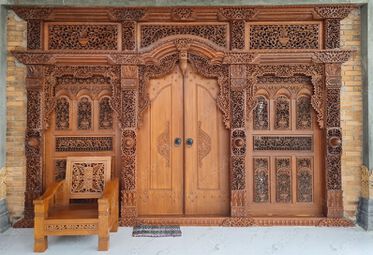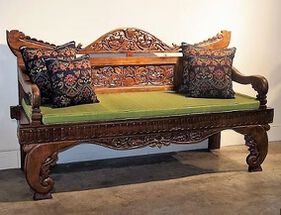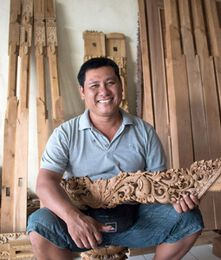Wood Carvings * Other Wood Carvings
To create a new page, enter a unique page name below.
If a page with that name already exists, you will be sent to a form to edit that page.
For existing pages ... see category Other Wood Carvings.
Fill in the form with the details of your image and save the page.
Wood Carving in Different Regions of Indonesia
The art of wood carving is quite well-developed in Indonesia. Other than tribal art woodcarvings of Asmat (west Papoea-New-Guinea), Dayak (Borneo), Nias (west Sumatra), and Toraja (south Sulawesi) area is well known for its refined wood carving culture; they are Jepara in Central Java, and Bali. Mas village near Ubud in Bali is renowned for their wood carving art.
Woodworking is arguably the most widely practiced art form in Indonesia. It seems like most ethnic groups and regional people practice it some form. The Asmat produce their famous totem-pole-like bis poles; the Toraja decorate their houses with images of buffalos and cocks; the Dayaks produce magical dog carvings; and the Batak protect their houses with horned lion heads. The center of woodworking in Java is the town of Jepura on the north coast of Central Java. Artists here produce traditional Hindu-Buddhist styles as well as Islamic styles. Other important centers include Kudus, known for its derailed panels, and Madura.
The cottage carving industry of Bali finds a wide domestic and international market for its statues of people, deities, and animals, many of which are finely artistic, some hackneyed. Perhaps the most common carving is in the urban furniture industry, mainly in Java, where ornately carved sofas and chairs are very popular. Traditional puppet or animal carvings of the mountain Batak of Sumatra or the upriver Dayak of Kalimantan are now mainly for tourists, though they once showed rich artistry (now largely seen in museums). The Toraja homes are still elaborately carved, and small examples of these carvings are sold to tourists. Toraja carve decorations on large bamboo tubes used for carrying palm wine or rice, and people in eastern Indonesia decorate small bamboo tubes that carry lime used in betel chewing.
The most famous woodcarving centers are Bali, Central Java, Madura, Sumatra and Papua. Whimsical, brightly colored modern carvings are produced primarily in Bali. And the popularity of these pieces has Modern Wood Carvings from Bali influenced the wooden carving traditions of other regions as well. Most popular with expats are Javanese and Balinese wooden image carvings, Jepara lattice-like three-dimensional reliefs and Papuan primitive carvings. Papuan tribes such as the Asmat, Dani, and Komoro have very distinctive styles of carvings of totem poles, weapons, figures and utensils.
Woodcarver Nyoman Jiwa
Nyoman Jiwa started learning the art of woodcarving from his grandfather when he was just 10 years old. A quiet, gentle man, this very talented artisan takes his role in life very seriously; dividing his wood carving into two distinct forms; business and art. The business aspect involves making cabinets, tables and chairs for private houses and villas and carving stone pieces for landscaping projects. Nyoman earns enough to feed his family and have a reasonable living, but his real woodcarving creativity is saved for special occasions such as cremation ceremonies or Odalan (temple ceremonies).
Nyoman helps construct bades (cremation towers that carry the deceased person’s bones to the place where the cremation takes place), which assists the families of those who have died. He helps facilitate people whose time it is to move to the next world or Niskala. When making a bade, Nyoman meditates to find inspiration from the Gods, which helps his creative inspiration and directs him to make something very special for the deceased family.
Nyoman lives in Gianyer regency, the home of woodcarvers and the centre of the arts in Bali, with a long history of religious tradition where woodcarvers like Nyoman are highly revered. In the words of Louis Nizer, a famous British-born American lawyer, “A man who works with his hand is a labourer, a man who works with his hand and his brain is a craftsman, but a man who works with his hand, his brain and his heart, is an artist.” On this basis, I have no doubt that this humble gentleman is indeed an artist, with the combination of heart, hand and head, and we all can only hope that his legacy will be passed down to the younger generation, as it has been in the past.
More info:
Wood carving furniture from Jepara City
Furniture and wood carving craft in Java Indonesia
The Ancient Art of Indonesian Woodcarving



